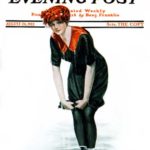Cover Gallery: Women Making a Difference
These early Post covers – all published before women had the right to vote – show that they were making significant contributions to society despite their unequal treatment under the law.

Edward Penfield
September 5, 1903
This cover was an illustration to accompany a story of a woman participating in a little insider trading in order to buy an obscenely expensive car. Is there anything more modern than that? To quote the protagonist, “If I could love a man as well as I do my Manton it would be a snap.”

Philip R. Goodwin
June 9, 1906
This cover illustrated a short story called “The Noose.” The cowgirl at the center of the story, Fan Blondell, “was already aware of her power, too, and walked among the rough men of her acquaintance with the step of an Amazonian queen, unafraid, unabashed.”

Clarence F. Underwood
February 18, 1911
Most of Clarence Underwood’s female subjects were demure and daintily dressed. The woman on our 1911 cover is quite a different story: arms crossed, cap at a rakish angle, and sword by her side, she looks ready to take on just about anybody. In the early 1900s, however, there were almost no military or police roles open to women. Try as we might, we could not identify her uniform — can you?

Neysa McMein
May 26, 1917
Those on the home front were recruited to do everything they could for the war effort, including making socks, collecting scrap, starting gardens, and, as the woman on this cover is doing, making bandages to ship to the front lines.

Neysa McMein
August 11, 1917
Artist Neysa McMein was involved in the war efforts during World War I, travelling through Europe with Dorothy Parker to entertain the troops. She painted a number of wartime covers, including this pilot.
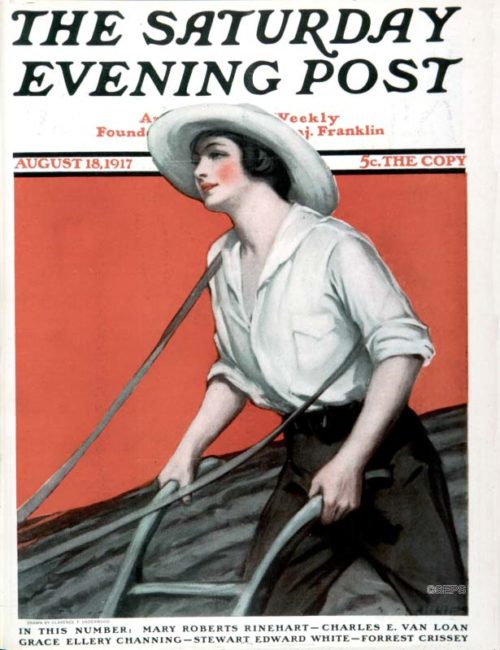
Clarence F. Underwood
August 18, 1917
With many men fighting the war overseas, the traditional work of men fell to the women. This included the decidedly unglamorous and backbreaking work of maintaining the family farm.

J.C. Leyendecker
August 17, 1918
The American Red Cross Motor Corps were a group of women who aided the U.S. military in transporting troops and supplies during World War I. These women did everything from running canteens and military hospitals to caring for patients of the 1918 flu pandemic.
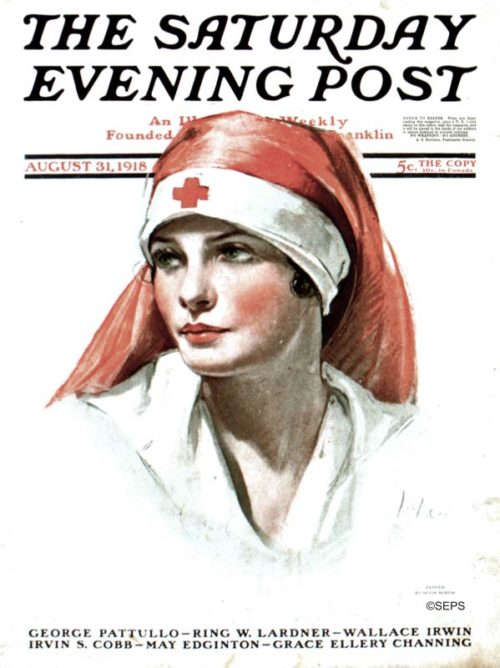
Neysa McMein
August 31, 1918
The role of the American Red Cross expanded significantly during World War I. During the war, the Red Cross mobilized more than 8 million volunteers, with one-third of all Americans serving as either volunteers or donors.

Neysa McMein
March 6, 1920
Although the 19th Amendment wasn’t ratified until August 18, 1920, women had the right to vote in 15 states. The first state or territory granting women the right to vote was Wyoming, in 1890. Twelve additional states allowed women to cast a vote for president prior to the 19th amendment.
Cover Gallery: Let It Snow!
The Saturday Evening Post loves a beautiful snowy day! (As long as we don’t have to drive anywhere. And it doesn’t turn to ice. And it’s not too cold. And it won’t last three more months. You get the idea.) Depending on your attitude toward frozen water, you’ll either love or loathe our cover gallery of winter fun, all from Post issues published before 1920.

George Gibbs
November 24, 1900

Henrietta Adams
January 23, 1909
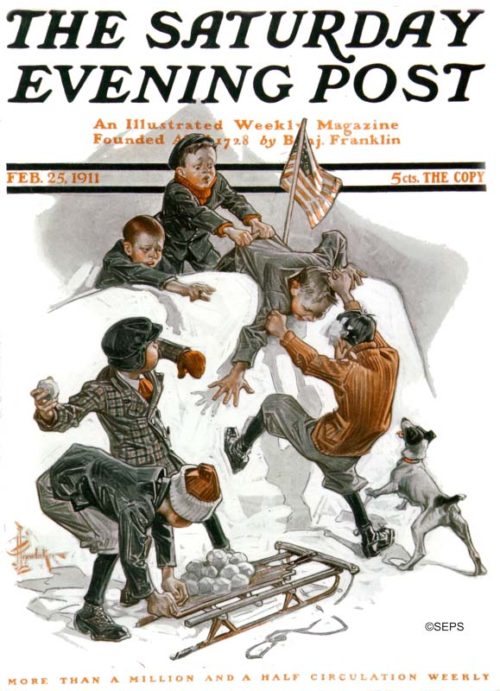
J. C. Leyendecker
February 25, 1911

Clarence F. Underwood
March 4, 1911

Penrhyn Stanlaws
January 10, 1914

Sarah Stilwell-Weber
February 10, 1917

Sarah Stilwell-Weber
January 25, 1919
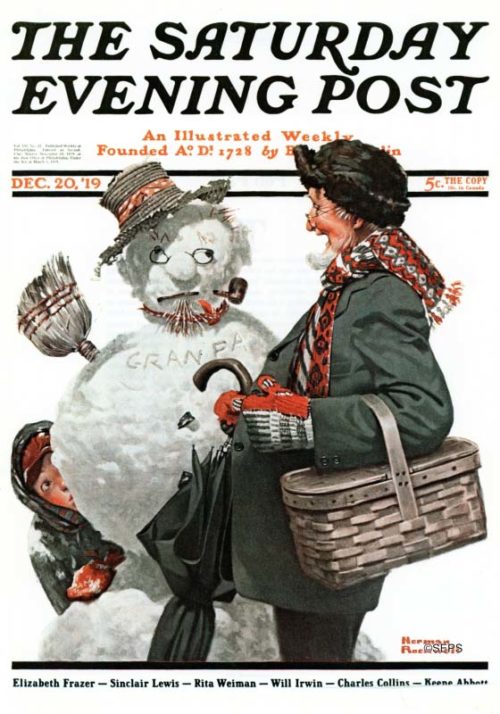
Norman Rockwell
December 20, 1919
Classic Covers: August Cool-Down
Is there any relief from this heat? Yes! It’s August, and the dog days of summer are upon us, but we found delightful covers from 1912 to 1955 showing ways to get wet and cool down. We wouldn’t recommend all of them.
Swimming Hole by Norman Rockwell

Norman Rockwell
August 11, 1945
© SEPS 1945
This is a charming story-in-a-picture of a salesman making a long drive on a hot August day. No air conditioning in the car, of course. He spots a swimming hole, pulls over and goes for it. He carefully lays his glasses on a newspaper and his lit cigar on his shoe, to be picked up when he emerges (Rockwell was all about details). And then shows us a face of pure bliss. “George Zimmer, my model,” reported Norman Rockwell, “was an awful good sport. He stripped and I poured several buckets of water over his head to get the effect.” And you thought modeling was easy!
Drink of Water by Frank X. Leyendecker

Frank X. Leyendecker
August 22, 1914
© SEPS 1914
We love this cover from August of 1914 by artist Frank X. Leyendecker (brother of Post cover artist J.C.). Frank did sixteen Post covers, and this one is delightful. Delivering papers in August is hot, tiring work, and the kid deserves a cool drink. The fact that his drinking buddy happens to be a horse doesn’t concern him.
Watering Father by Richard Sargent

Richard Sargent
June 4, 1955
© SEPS 1955
We’d all like to see this scene three seconds later, but this is what we have to work with. While Mom is busy planting and watering flowers, Junior is thinking Dad’s pasty white skin needs a cool-down. Whether Dad agreed it was a good idea is a mystery left up to the viewer. Sargent was great with humorous scenes and a master at the pregnant pause, the “what-happens-next” moment.
Wet Swim Suit by Clarence F. Underwood

Clarence F. Underwood
August 24, 1912
© SEPS 1912
We know, you’re shocked. A pretty young lady in a swimsuit on the cover of the staid and venerable Saturday Evening Post. And in 1912 yet! Well, even young ladies in 1912 deserved a cool-down. At least we don’t have to wring out the heavy skirts of our swimsuits these days. Artist Clarence F. Underwood did over forty Post covers. Even though most of them were in the 19-teens, many showed active women: fishing, playing tennis, canoeing, even plowing a field. Of course, they looked surprisingly pretty doing all this.
Sitting on the Diving Board by Penrhyn Stanlaws

Penrhyn Stanlaws
August 19, 1933
© 1933 SEPS.
My, how bathing suits changed in a mere twenty-one years! In a swimsuit more suited for immersion, the pretty lady from 1933 is just dipping her toes in the water. Go figure. Curtis Publishing (curtispublishing.com) shows many gorgeous Stanlaws covers, usually of lovely young ladies holding a teacup or bouquet. He did a total of thirty-seven Post covers between 1913 and 1938. (Warning: if you look up his covers on the Curtis website, you’ll want to buy prints of them all.)
Cool Bear by Charles Livingston Bull
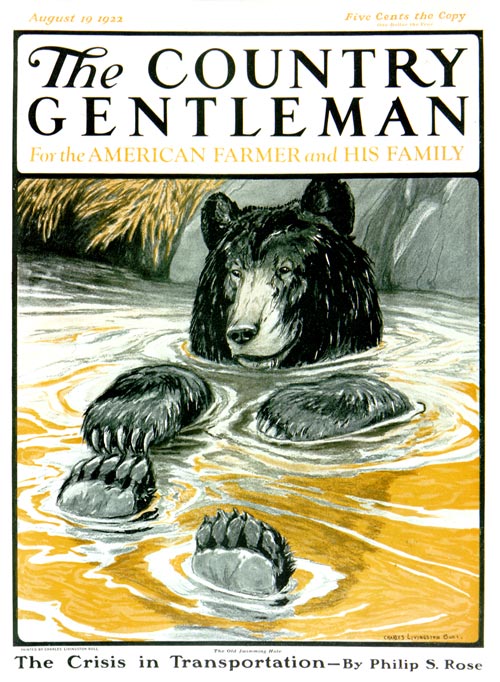
Charles Livingston Bull
August 19, 1922
© SEPS 1922
Then there’s the total immersion therapy. This is from Country Gentleman magazine (a sister publication) in 1922 by great wildlife artist, Charles Livingston Bull. If that water looks good to you, a word of advice: Find another place to cool down.
Classic Covers: Dog Days of Summer
It’s an all out neighborhood war! The June 30, 1951, cover shows a passel of kids in a multiyard battle with garden hoses. Ah, the days before Super Soaker squirt guns. Pedestrians wisely steer clear, even though a squirt of cold water might feel pretty good on this hot summer day. (Try to get these same children to take a bath, and there would be heck to pay.)
Kids and fire hydrants go back a long way. A July 1915 cover shows us a little girl, baby, and dog cooling down with the help of a handy water source.
Sometimes you gotta pay to play. Stevan Dohanos’ baseball player of July 1946 is mowing the lawn as fast as he can so he can get to the game–while the team awaits. And sometimes you just gotta play. John Falter’s boys swinging into the water of San Francisco Bay looks risky, but the editors insisted, “If a small boy, when at play, is not doing something perilous, he must be sick.”
Perhaps less perilous (at least for the humans pictured, if not the dog) is the August 1952 cover, No Girls Allowed. Hoisting the dog up into the tree house, the boys know how to spend a summer day without video games, cell phones, or TV. E.M. Jackson’s kids in a water fountain found an inexpensive way to cool off in July of 1926.We certainly hope they don’t get in trouble.
Grown-ups, too, have their way of getting through the “dog days,” as demonstrated by the young lady in the August 24, 1912, cover by Artist Clarence F. Underwood. Check out the bathing suit! Not our idea of hot-weather attire, but probably 1912’s idea of a pin-up girl.
One of the most relaxing covers of a summer afternoon is John Atherton’s Sleeping Farmer of 1947. Under a shady tree, the normally busy land worker can’t resist a snooze, and it’s such a lazy day, even the cows and horses seem to be napping with him.
But no one knew how to spend the dog days of summer better than Norman Rockwell. His August 11, 1945, salesman couldn’t resist pulling the car over, stripping down, and getting up to his neck in cool water. (We won’t tell the boss.) Rockwell’s sailor on leave makes us envious of his downtime, even if well deserved. It’s hard to get more relaxed than a man and dog in a hammock on a sun-dappled afternoon. The sailor had to borrow his shipmate’s shirt for the decorations on the chest. Rockwell borrowed the dog from his own son, the hammock from a neighbor, the house from yet another neighbor, and Rockwell’s own shoes complete the picture. Somehow it comes together enough to make us want to find a hammock and snooze a dog day away.
Water Fight
June 6, 1951
Fire Hydrant Shower
July 24, 1915
Baseball Player Mowing the Yard
July 20, 1946
San Fransisco Bay Boys
May 26, 1956
No Girls Allowed
August 9, 1952
Swimming in Fountain
July 24, 1926
Wet Swimsuit
August 24, 1912
On Leave
September 15, 1945
Sleeping Farmer
August 23, 1947
Swimming Hole
August 11, 1945






